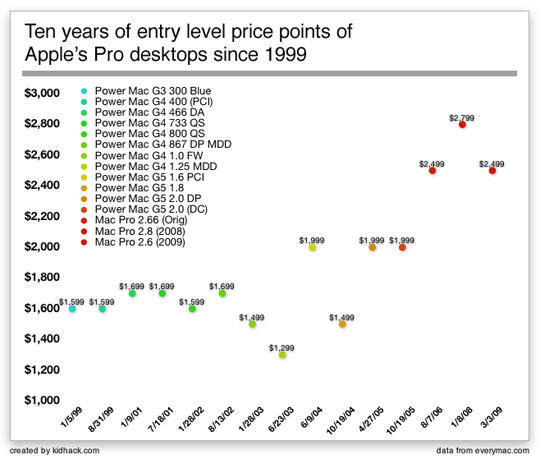The often interesting, always entertaining Dr. Macenstein posted the chart above Tuesday night seeking to explain and illuminate the perennial complaints about price vs. perceived value of new machines that surface whenever Apple has the temerity to upgrade its product lines.
In the end, the Dr. was left to conclude, “The only thing I can think is that when Apple ditched the plastic chassis of the G4 towers in favor of aluminum (or “all-oo-min-ee-um”, as our cute little “petrol-saying” UK readers call it), they didn’t anticipate that today we’d be in the midst of a massive aluminum shortage which has caused the precious metal to eclipse gold in value.”
Follow after the jump for an analysis of where the Doc gets it wrong and what to make of the so-called “Apple premium.”
From 1999 to 2004, Aluminum traded on world commodities exchanges in a tight range between 62¢ and 75¢ per pound. Right around the time Apple probably started to toy with the idea of aluminum unibody manufacturing, Aluminum did begin a parabolic climb, topping out at $1.40 per pound in 2006 before falling back, and then climbing again to just best the high at $1.51 per pound in July of 2008.
Since last summer’s peak, however, aluminum has been in a freefall, closing trading on the NY Mercantile Exchange Tuesday at the low end of its decade long trading range, just over 60¢ per pound.
A couple of things are worth noting from this information. It is likely that Apple paid premium prices for the Aluminum used in manufacturing the unibody notebooks the company released in 2008 and in the machines it announced Tuesday. But it would be way off the mark to think Aluminum has or ever will approach the value of gold in price, and it would be unwise to believe Steve Jobs would not have allocated at least some resources to trading in the Aluminum futures market to hedge the company’s risk once it decided to commit to the unibody aluminum design for its products.
A more telling explanation for the perceived inflationary trend in the cost of new Apple computers illustrated by the chart above lies in an analysis of the value of the US dollar, which, at its lows in (coincidentally enough) July of 2008, was worth a little better than half of its highest value in the past decade.
Is there really an Apple premium in the computing economy? Are new Apple machines really more expensive today than they have ever been? Are the improvements in CPU performance, storage and memory capacity worth the perceived increase in cost?
These are questions hard to quantify in a time as economically volatile and uncertain as the one we confront today.
Based on the dollar value differential, however, the $1700 Power Mac G4 of 2001 would have cost around $1785 in today’s dollars at the time. The $2000 Power Mac G5 of 2005 would have cost about the same in today’s dollars due to the greenback’s rise from its lows in the past year.
So the question one ought to ask is whether the 2009 Mac Pro is worth $500 more than the 2005 Power Mac G5.
In the end, though, it’s all moot.
One either sees and accepts the value of Apple machines or one doesn’t. And disagreements between the two camps of people are what keep blogs such as this one in business.



